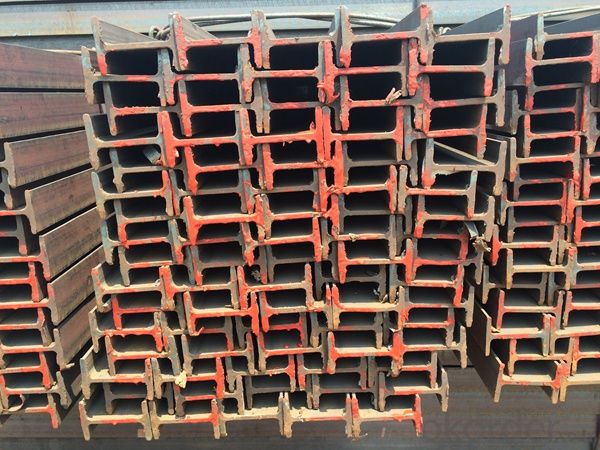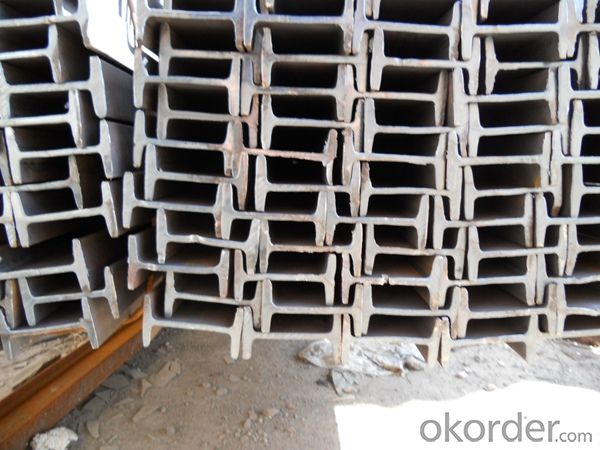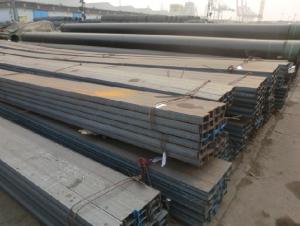IPEAA, IPE Beams of EN Production Standard Q235
- Loading Port:
- Tianjin
- Payment Terms:
- TT OR LC
- Min Order Qty:
- 25 m.t.
- Supply Capability:
- 200000 m.t./month
OKorder Service Pledge
OKorder Financial Service
You Might Also Like
Product Description:
OKorder is offering IPEAA, IPE Beams of EN Production Standard Q235 at great prices with worldwide shipping. Our supplier is a world-class manufacturer of steel, with our products utilized the world over. OKorder annually supplies products to European, North American and Asian markets. We provide quotations within 24 hours of receiving an inquiry and guarantee competitive prices.
Product Applications:
IPEAA, IPE Beams of EN Production Standard Q235 are ideal for structural applications and are widely used in the construction of buildings and bridges, and the manufacturing, petrochemical, and transportation industries.
1. Supporting members, most commonly in the house raising industry to strengthen timber bears under houses. Transmission line towers, etc
2. Prefabricated structure
3. Medium scale bridges
4. It is widely used in various building structures and engineering structures such as roof beams, bridges, transmission towers, hoisting machinery and transport machinery, ships, industrial furnaces, reaction tower, container frame and warehouse etc.
Product Advantages:
OKorder's Steel I-Beams are durable, strong, and resist corrosion.
Main Product Features:
· Premium quality
· Prompt delivery & seaworthy packing (30 days after receiving deposit)
· Corrosion resistance
· Can be recycled and reused
· Mill test certification
· Professional Service
· Competitive pricing
Product Specifications:
1. Product name: IPEAA, IPE Beams of EN Production Standard Q235
2. Standard: EN10025, GB Standard, ASTM, JIS etc.
3. Grade: Q235B, A36, S235JR, Q345, SS400 or other equivalent.
4. Length: 5.8M, 6M, 9M, 10M, 12M or as your requirements

Section | Standard Sectional Dimensions(mm) | ||||
h | b | s | t | Mass Kg/m | |
IPE80 | 80 | 46 | 3.80 | 5.20 | 6.00 |
IPE100 | 100 | 55 | 4.10 | 5.70 | 8.10 |
IPE120 | 120 | 64 | 4.80 | 6.30 | 10.40 |
IPE140 | 140 | 73 | 4.70 | 6.90 | 12.90 |
IPE160 | 160 | 82 | 5.00 | 7.40 | 15.80 |
IPE180 | 180 | 91 | 5.30 | 8.00 | 18.80 |
IPE200 | 200 | 100 | 5.60 | 8.50 | 22.40 |
IPE220 | 220 | 110 | 5.90 | 9.20 | 26.20 |
IPE240 | 240 | 120 | 6.20 | 9.80 | 30.70 |
IPE270 | 270 | 135 | 6.60 | 10.20 | 36.10 |
IPEAA80 | 80 | 46 | 3.20 | 4.20 | 4.95 |
IPEAA100 | 100 | 55 | 3.60 | 4.50 | 6.72 |
IPEAA120 | 120 | 64 | 3.80 | 4.80 | 8.36 |
IPEAA140 | 140 | 73 | 3.80 | 5.20 | 10.05 |
IPEAA160 | 160 | 82 | 4.00 | 5.60 | 12.31 |
IPEAA180 | 180 | 91 | 4.30 | 6.50 | 15.40 |
IPEAA200 | 200 | 100 | 4.50 | 6.70 | 17.95 |
FAQ:
Q1: Why buy IPEAA, IPE Beams of EN Production Standard Q235 from OKorder.com?
A1: All products offered by OKorder.com are carefully selected from China's most reliable manufacturing enterprises. Through its ISO certifications, OKorder.com adheres to the highest standards and a commitment to supply chain safety and customer satisfaction.
Q2: How do we guarantee the quality of IPEAA, IPE Beams of EN Production Standard Q235?
A2: We have established an advanced quality management system which conducts strict quality tests at every step, from raw materials to the final product. At the same time, we provide extensive follow-up service assurances as required.
Q5: Can IPEAA, IPE Beams of EN Production Standard Q235 rust?
A5: Yes, but a little, but it dosen't afect the usage.


- Q:Can steel I-beams be used in energy-efficient building renovations?
- Yes, steel I-beams can be used in energy-efficient building renovations. Steel I-beams offer several advantages that make them suitable for energy-efficient renovations. Firstly, steel is a highly durable and strong material, allowing I-beams to provide structural support while reducing the need for excessive materials and construction. This can help minimize waste during renovation projects. Additionally, steel I-beams have a high load-bearing capacity, allowing for the creation of open floor plans and the integration of large windows, which enhances natural lighting and reduces the need for artificial lighting during the day. Furthermore, steel is a sustainable material that can be recycled, reducing the environmental impact of the renovation process. The use of steel I-beams also allows for the incorporation of insulation materials, such as spray foam or rigid foam, which can significantly improve the building's energy efficiency by reducing heat transfer. Moreover, steel I-beams can be designed to support the installation of energy-efficient systems, such as solar panels or green roofs, which contribute to the overall energy efficiency of the building. These systems can generate renewable energy and reduce the building's reliance on traditional energy sources. In conclusion, steel I-beams can be effectively used in energy-efficient building renovations. Their strength, durability, recyclability, and compatibility with energy-efficient systems make them a suitable choice for sustainable and environmentally friendly building projects.
- Q:Can steel I-beams be used for industrial platforms?
- Yes, steel I-beams can be used for industrial platforms. Steel I-beams are a popular choice for industrial platforms due to their strength and durability. They are capable of supporting heavy loads and are resistant to bending or warping, making them ideal for industrial applications. Additionally, steel I-beams can be easily fabricated and customized to specific size and shape requirements, allowing for flexibility in design. Overall, steel I-beams are a reliable and cost-effective option for constructing industrial platforms.
- Q:Can steel I-beams be used for temporary support during renovations or repairs?
- Certainly! Steel I-beams are a suitable choice for temporary support when renovating or repairing. Renowned for their robustness and ability to bear heavy loads, they are perfect for providing temporary support during construction or repair work. Typically, they are employed to reinforce walls, ceilings, and floors, guaranteeing the overall safety and stability of the structure. However, it is crucial to seek advice from a structural engineer or a professional contractor to ascertain the appropriate dimensions and type of steel I-beam necessary, tailored to the specific load requirements of the project.
- Q:What are the different types of steel I-beam connections for lateral stability?
- Lateral stability can be achieved in steel construction through various types of connections for steel I-beams. Some commonly used options are as follows: 1. Welded connections: This type of connection is extensively employed in steel construction. It involves welding the flanges and webs of two I-beams together to establish a strong and rigid connection. Welded connections offer exceptional lateral stability and are commonly utilized in critical structures like high-rise buildings. 2. Bolted connections: By using bolts and nuts, two I-beams can be connected through bolted connections. This type of connection is preferred when the I-beams require easy disassembly or adjustment. Proper design and installation of bolted connections can ensure good lateral stability. 3. Moment connections: Designed to transfer both axial and bending forces between two I-beams, moment connections are more intricate and expensive compared to other connection types. However, they offer excellent lateral stability and are commonly utilized in structures that anticipate significant loads or bending moments. 4. Shear connections: Shear connections facilitate the transfer of shear forces between two I-beams. Typically created using bolts or welds, these connections are relatively straightforward to design and install. When combined with other connection types, shear connections can provide reliable lateral stability. 5. Gusset plate connections: Gusset plate connections involve the use of a plate to connect two I-beams. The plate is commonly welded or bolted to the flanges and webs of the I-beams, enhancing lateral stability. Gusset plate connections are often employed when other connection types are impractical or unfeasible. In conclusion, the selection of a suitable steel I-beam connection for lateral stability depends on various factors, including structural requirements, load conditions, design limitations, and cost considerations. A thorough evaluation of these factors and consultation with a structural engineer is crucial in determining the most appropriate connection type for a specific project.
- Q:What are the different types of steel connections used for I-beams in renovations?
- There are several different types of steel connections that are commonly used for I-beams in renovations. These connections are designed to provide structural support and stability to the I-beams, ensuring that they can effectively bear the weight and loads placed upon them. One common type of steel connection used in renovations is the bolted connection. This involves using bolts and nuts to secure the I-beam to other structural elements, such as columns, beams, or plates. Bolted connections are highly versatile and can be easily adjusted or modified if needed. They provide a strong and reliable connection, making them suitable for a wide range of renovation projects. Another type of steel connection is the welded connection. This involves welding the I-beam to other steel components, creating a permanent and seamless joint. Welded connections offer excellent strength and rigidity, making them ideal for heavy-duty applications. However, it is important to ensure proper welding techniques are used to maintain the integrity of the connection. In addition to bolted and welded connections, there are also specialized steel connections available for specific renovation scenarios. For instance, moment connections are used when there is a need to resist rotational forces or moments. These connections are designed to provide extra rigidity and stability to the I-beams, preventing any unwanted movement or deflection. Moreover, there are also eccentric connections that are used when the center of gravity of the I-beam does not align perfectly with the connecting element. These connections are designed to accommodate this eccentricity and ensure a secure and stable connection. Overall, the choice of steel connection for I-beams in renovations will depend on factors such as the load requirements, structural design, and specific project constraints. Consulting with a structural engineer or construction professional is essential to determine the most suitable steel connection type for a particular renovation project.
- Q:Are steel I-beams suitable for multi-story buildings?
- Yes, steel I-beams are suitable for multi-story buildings. Steel I-beams are commonly used in construction due to their strength, durability, and load-bearing capabilities. They provide structural support and stability to the building, allowing for the construction of multiple floors and the ability to withstand heavy loads. Additionally, steel I-beams can be easily fabricated and customized to meet the specific needs and requirements of multi-story buildings. Their versatility and availability make them a popular choice for constructing high-rise buildings and other multi-story structures.
- Q:What are the cost implications of using steel I-beams in construction?
- The cost implications of using steel I-beams in construction can vary based on multiple factors. To begin with, the initial cost of steel I-beams is generally higher in comparison to alternative building materials like wood or concrete. This is due to steel being a premium material renowned for its strength, durability, and load-bearing capabilities, making it a preferred choice for supporting heavy structures. However, it's worth noting that steel I-beams tend to have a longer lifespan and require less maintenance than other materials, leading to potential cost savings in the long term. Moreover, the cost of utilizing steel I-beams in construction is influenced by the size and weight of the beams required for the project. Naturally, larger and heavier beams will be more expensive due to the increased amount of steel needed and the associated costs of transportation and handling. Another cost consideration is the installation process. Proper installation of steel I-beams necessitates specialized equipment and skilled labor, which can contribute to the overall project expenses. Nonetheless, the speed and ease of installation can offset these costs by reducing construction time and labor hours. Furthermore, steel is an adaptable material that can be easily recycled, adding to the sustainability aspect of using steel I-beams. This can result in potential cost savings through recycling incentives or reduced waste disposal fees. Overall, while the upfront cost of using steel I-beams in construction may be higher, the long-term benefits of durability, reduced maintenance, and potential sustainability advantages can outweigh the initial investment. It is crucial to carefully evaluate the specific project requirements, structural needs, and budget constraints to determine the most cost-effective solution.
- Q:What are the common finishes for steel I-beams?
- The common finishes for steel I-beams include hot-dip galvanizing, priming and painting, and powder coating. Hot-dip galvanizing is a process that involves coating the steel I-beam with a layer of zinc, protecting it from corrosion and ensuring its longevity. This finish is commonly used in outdoor applications where the I-beam will be exposed to moisture or harsh environmental conditions. Priming and painting is another common finish for steel I-beams. It involves applying a layer of primer to the surface of the I-beam to enhance adhesion, followed by one or more coats of paint. Priming and painting not only provide a protective barrier against corrosion but also allow for customization in terms of color and appearance. Powder coating is a finish that involves electrostatically applying a dry powder onto the surface of the I-beam. The powder is then cured under heat, forming a hard and durable finish. Powder coating offers excellent corrosion resistance, as well as a wide range of color options and a smooth, even appearance. It is worth mentioning that the choice of finish for steel I-beams depends on the specific requirements of the application. Factors such as the environment, aesthetic preferences, and level of corrosion resistance needed should be taken into consideration when selecting the appropriate finish for steel I-beams.
- Q:Can steel I-beams be used for convention centers or exhibition halls?
- Certainly, convention centers or exhibition halls can make use of steel I-beams. Steel I-beams are widely favored for extensive structures due to their robustness, longevity, and adaptability. They offer exceptional load-bearing capacities, enabling the creation of expansive and unobstructed areas, which are essential for convention centers and exhibition halls. Furthermore, steel I-beams can be effortlessly manufactured and installed, rendering them an economical choice for such colossal and intricate constructions. By incorporating steel I-beams in convention centers and exhibition halls, we guarantee the ability to sustain substantial loads, accommodate large gatherings, and provide the necessary flexibility for various event arrangements and setups.
- Q:Are steel I-beams affected by temperature fluctuations?
- Yes, steel I-beams are affected by temperature fluctuations. Steel expands when exposed to high temperatures and contracts when exposed to low temperatures. These temperature changes can cause the I-beams to expand or contract, leading to potential structural issues such as warping, buckling, or deflection. Therefore, it is important to consider and account for the effects of temperature fluctuations in the design and maintenance of steel I-beams.
1. Manufacturer Overview |
|
|---|---|
| Location | |
| Year Established | |
| Annual Output Value | |
| Main Markets | |
| Company Certifications | |
2. Manufacturer Certificates |
|
|---|---|
| a) Certification Name | |
| Range | |
| Reference | |
| Validity Period | |
3. Manufacturer Capability |
|
|---|---|
| a)Trade Capacity | |
| Nearest Port | |
| Export Percentage | |
| No.of Employees in Trade Department | |
| Language Spoken: | |
| b)Factory Information | |
| Factory Size: | |
| No. of Production Lines | |
| Contract Manufacturing | |
| Product Price Range | |
Send your message to us
IPEAA, IPE Beams of EN Production Standard Q235
- Loading Port:
- Tianjin
- Payment Terms:
- TT OR LC
- Min Order Qty:
- 25 m.t.
- Supply Capability:
- 200000 m.t./month
OKorder Service Pledge
OKorder Financial Service
Similar products
New products
Hot products
Related keywords





























